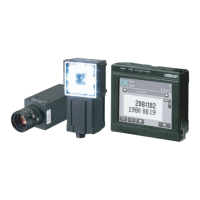Control and Output in No-Protocol (TCP) / No-Protocol (UDP)
FQ2-S/CH User’s Manual
for Communications Settings
183
3
Controlling Operation and Outputting Data with an
Ethernet Connection
Binary Data File Load and Save Commands
These commands allow various types of sensor data to be saved in binary data format.
Use these commands when you want to directly control scene data and system data from the external device
side (user side) rather than the sensor side. For this purpose, a send/receive program is created on the user
side, and the commands are incorporated into the program. Be sure to have a good understanding of binary
data and the send/receive system before considering use of these commands.
These commands can also be used in no-protocol TCP communication. The commands cannot be used in no-
protocol UDP communication or no-protocol RS-232C communication.
How to Execute Binary Data File Load/Save Commands
Two command types are available for these commands: check commands and run commands.
To execute one operation, control must be performed using a combination of the two types of commands.
• Check command: Sends notification of the size of the binary data to be saved or loaded.
• Run command: Executes saving or loading of binary data.
If the check command is not executed, the run command that executes saving/loading of binary data will not be pro-
cessed properly.
Using the Commands
Create the command send/receive program so that the check command is always executed before the run
command. Command execution is accomplished by the user-created send/receive program that incorporates
the check commands and run commands in the above order.
Saving and loading of binary data using check commands and run commands is as shown below.
FQ2-S_CH_comm.book 183 ページ 2014年6月26日 木曜日 午前11時47分

